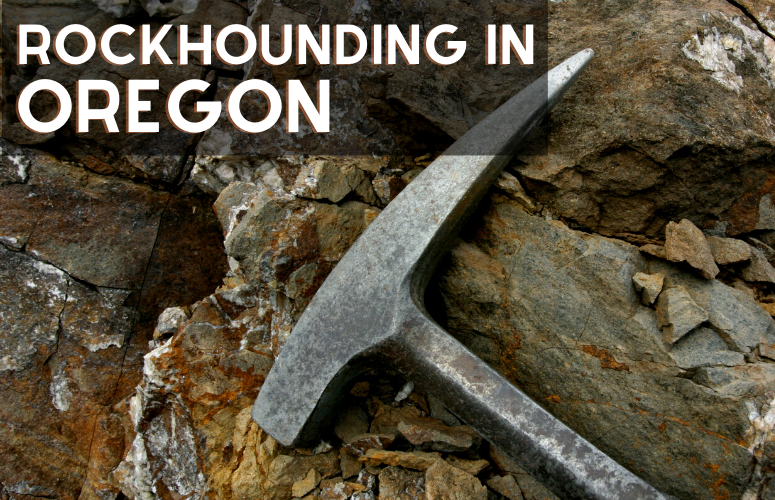
Oregon is without a doubt one of the top states for rockhounding in the country.
The fascinating and diverse geology of Oregon provides and abundance of different rocks and minerals for collectors to find. Additionally, there are a number of sites where you can collect fossils and petrified wood. Prime collecting sites span across the entire state of Oregon, and regardless of where you live there is a good chance that there are some collectable rocks nearby.
This article is going to take a look at some of the prime locations to search for various rocks, gems, fossils, and even gold! We will also take a detailed look at the regulations regarding rock collecting here, so you can be certain that you are following all laws to avoid getting into trouble on your next rockhounding adventure.
There is an incredible variety of minerals that can be found across the state, but for most collectors, there are a few that stand out.
Oregon’s Most Popular Rocks & Fossils for Collecting
Thundereggs Agate Jasper Obsidian Quartz Petrified Wood Invertebrate Fossils Sunstone
While some may think of this as a rather short list, the truth is that a huge variety of different materials are sources from these types of rocks. Each type of material can be found in a variety of different colors and textures depending on the areas that they are sourced.
Many of these minerals are found throughout the state, while a few are more isolated in specific locations. We will detail this in more detail in this article, with some popular rockhounding sites separated by region.
Oregon Rockhounding Laws
The rules and regulations regarding rockhounding vary depending on the location, specifically who owns/manages the land where the rocks are located. It is incredibly important of all rockhounds to know where they are before they do any digging or collecting. Failure to ignore this important step could easily result in fines or even criminal trespass charges.
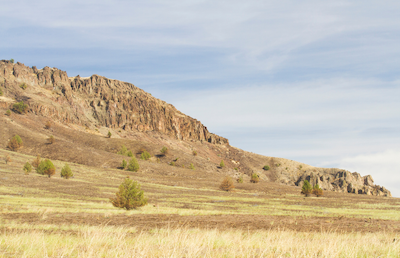
There are thousands of acres on square miles that you can legally collect rocks in Oregon. Before you leave the house, you need to spend a little time to make sure the place you intend to search is legally open for rockhounding. Private land, active mining claims, wilderness areas, etc. all need to be researched to ensure you are collecting legally.
Collecting Rocks on Private Lands in Oregon
Nearly 40% of all the land in Oregon is privately owned. This may or may not provide a collecting opportunity depending on who owns the land. You are legally allowed to collect on most private lands as long as you have permission from the landowner. Permission is key… don’t just assume that it’s ok. Otherwise you could be charged with criminal trespass.
Some of the BEST rockhounding sites in Oregon are actually on private land, and you can pay a fee to dig there. A few of the best-known pay-to-dig sites include:
Pay-to-dig Rockhounding Sites in Oregon
Richardson’s Rock Ranch – thundereggs
Polka Dot Mine – agate
Lucky Strike Mine – thundereggs
Spectrum Sunstone Mine – sunstone
Dust Devil Mining Company – sunstone
Double Eagle Mine – sunstone
Public Land Rockhounding in Oregon
About 53% of Oregon is classified as public land. Most of this land is open for rock collecting. However, you should know that not all public land is created equal!
Most lands managed by the US Forest Service (USFS) and Bureau of Land Management (BLM) are open to rockhounding, but there are exceptions. You cannot dig material from designated wilderness areas or National Recreation Areas. Some areas may allow limited surface collecting, but others will be off-limits.
It will be best to check with the agency that manages the specific areas you intend to go if you venture into one of these areas. Realistically, you aren’t likely to get into any trouble if you put a rock or two in your backpack. However, digging holes or collecting large amounts is likely to cause problems for you.
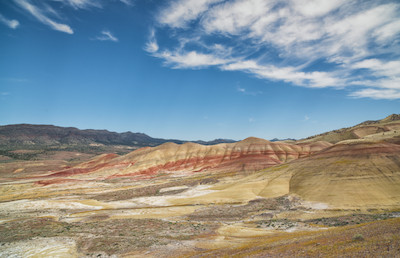
Rock collecting is not allowed within National Parks or National Monuments. You might be tempted to look for fossils on a visit to the Painted Hills. I wouldn’t recommend it!
Collecting rocks or fossils within national parks or national monuments is strictly off-limits. This includes Crater Lake National Park and the John Day Fossil Beds National Monument. It may be tempting to look for fossils at John Day Fossil Beds, but don’t even think about it. If you get caught the penalties will be severe.
Smaller county and regional parks can be great places to look for rocks. Many of these provide good access to rivers with good gravel bars. Regulations will vary, but most of the time casual rockhounding is ok. Just be sure to adhere to any rules that are posted at the parks.
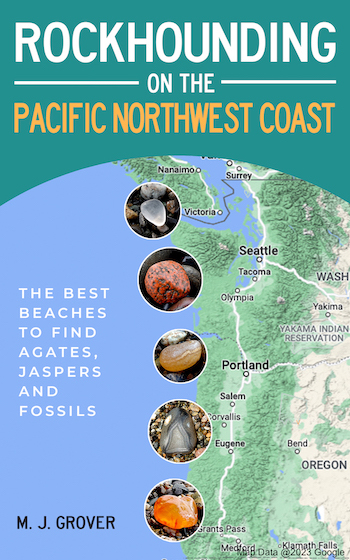
New PNW Rockhounding Book available on Amazon.
Northwest Oregon Rockhounding Areas
Northwest Oregon has plenty of good areas to go out and collect rocks. Agates and jaspers are the prize here. The best opportunities will be found along the gravel bars of the creeks and rivers that drain from the Cascade Mountains down to the Willamette River. Rivers and creeks the flow through the Coast Range and drain into the Pacific Ocean can also be very productive.
There are a few noteworthy areas. One great site to explore is the Wilson River about 1 hour west of Portland. There is a long section of the river that flows through the Tillamook State Forest, providing miles of public access. Explore the gravel bars in summer and fall when the water levels are low and the rocks are exposed.
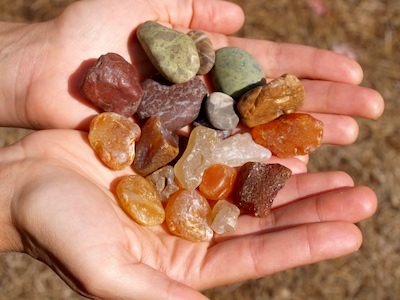
A variety of agates and jaspers collected from the rivers of Western Oregon. A few of these were found on the shores of the Oregon Coast.
The Willamette River is great place to explore, especially for city-dwellers in Eugene, Salem and Portland. There are lots of parks that provide access to the river where you can explore. Serious agate hunters use kayaks to venture out and explore gravel bars away from the crowds. I’ve seen some incredible carnelian agates found on the Willamette River.
Another cool area to check out is the Quartzville Recreation Area near Sweet Home. This is an area popular with gold prospectors, and is one of the better areas in Northwest Oregon to pan for gold.
Rockhounding along the Oregon Coast
The Oregon Coast provides the best accessibility for rockhounds in the whole state. The entire coastline in Oregon is designated as a state park, which means that every bit of it is accessible to the public.

The Oregon Coast can have incredible rockhounding. Avoid sandy beaches and look for exposed gravel beds instead. These beautiful carnelian agates are a nice prize after a long day. Also keep your eyes open for petrified wood, jasper, and marine fossils.
With over 363-miles of coastline, there are countless beaches that you can explore. Here are a few noteworthy ones:
Rockhounding Beaches on the Oregon Coast
Lost Creek State Park – 7 miles south of Newport
Short Beach – 1 miles north of Oceanside
Nelscott Beach – Lincoln City
Beverly Beach – 6 miles north of Newport
Agate Beach – Port Orford Get a copy of Agate Hunting on the Oregon Coast for a great guidebook to 40 of the best agate hunting sites on the Oregon Coast.
Southwest Oregon Rockhounding Areas
Most of the rivers in Southwest Oregon are going to turn up some decent agate, jasper and perhaps even some petrified wood specimens. You really can’t go wrong. Scour the gravel bars and keep a sharp eye out for anything that stands out.
The Umpqua River is good place to start your search. There is good access to many stretches of this river, and during the summer the low water levels allow you to explore lots of different areas. The same can be said for the Rogue River, although it will run higher all year-round, there is ample public access particularly around Galice within the Hellgate Recreation Area. Pistol River and Chetco River are also good to explore.
Althouse Creek has rare pink rhodonite. Just be aware that most of the creek has mining claims on it due to the rich gold deposits it contains.
This is also historic gold mining country, and there are several public accesses where you can find gold. These areas are all open to the public and unclaimed. Great for casual gold prospecting.
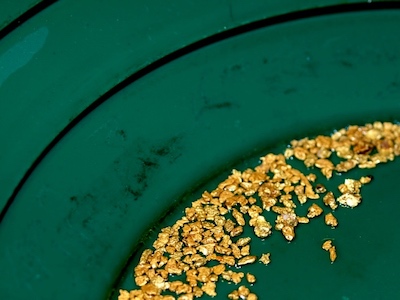
Miners have been searching for gold in the mountains and streams of SW Oregon since the 1850s. Incredible amounts of gold have been found in the Applegate, Illinois, Rogue and Umpqua Rivers. Many small tributaries also contain gold that can be panned. Be sure to stay off of any active mining claims.
Public Gold Panning Sites in Southern Oregon
Gold Nugget Waysides – roadside pullouts near Gold Hill
Cow Creek Recreation Area – near Roseburg, a tributary to the Umpqua River
Rogue River – within the Hellgate Recreation Area
Tunnel Ridge & Little Applegate – access to the Applegate River
Sixes River – public mining site about 10 miles east of Sixes Prospecting on the Rogue River is strictly “hands and pan” with no hand tools allowed. New regulations on in-stream sluices and motorized equipment have been recently enacted in much of Oregon. Be sure to check the latest information on any new regulations that may be in place.
Central Oregon Rockhounding Areas
If there is one “Mecca” for Oregon rockhounds, it would have to be central Oregon. There are an abundance of different minerals to collect here, but the most well-known would have to be thundereggs. There are countless agate beds found primarily in the area east of Madras and Prineville. These ‘eggs are unique, with different beds producing distinguishably different materials.
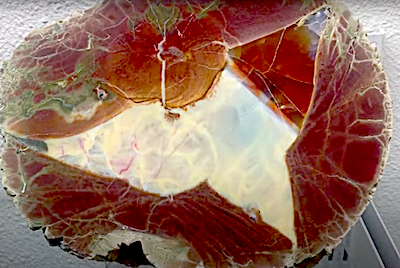
Central Oregon has some awesome rockhounding. Thundereggs are probably the main draw. There are several areas here where you can dig some fantastic pieces. The appreciate their beauty, you’ll have to have someone cut them for you. All of the pay-to-dig sites will do this for you for a modest fee.
The previously mentioned Richardson Rock Ranch is the most well-known in the area, but there are many other digging sites located on public lands around here too. The Ochoco National Forest has several sites to explore.
Petrified wood hunters would be advised to explore Hampton Butte east of Bend. There are variety of opalized wood species found at this site. Many other sites throughout Central Oregon have petrified wood and many plant fossils. There’s a popular digging site in the town named Fossil on the hillside behind Wheeler High School. For just $5 per day, you can dig for fossils that date back 33 million years.
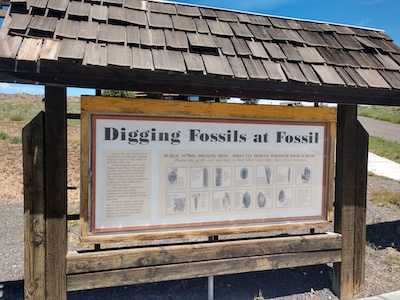
At Wheeler High School in Fossil, Oregon, you can dig for fossils dating back 33 million years. Cost is only $5 per person. Pay at the kiosk near the parking lot.
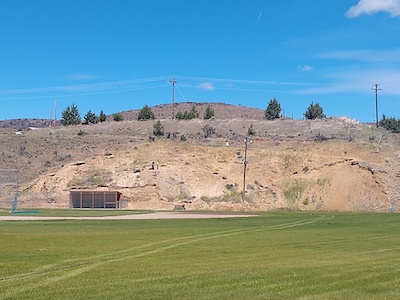
The white hills behind the school contain a wide variety of invertebrate fossils. Bring a good wide-brimmed hat… it can get hot under that summer sun!
Eastern Oregon Rockhounding Areas
Little Glass Butte is located between Bend and Burns. There’s not a whole lot out here, so make sure you are prepared before you leave. If you make the trip, you will be rewarded with some exceptional obsidian material coming in a wide array of colors.
All of the forks of the John Day River are worth exploring. There is nice jasper material here that will take a nice polish in a rock tumbler.
Beautiful sunstones are found in the remote desert near Plush, Oregon. There are several pay-to-dig sites in this area (mentioned above), but there is also a large public collecting area that sits on BLM land called the Sunstone Public Collection Area. It covers 2,500 acres and is a great site.
Close to the Idaho border, a beautiful area called Leslie Gulch is one of the best rockhounding areas in the state. Nearly all the land here is public, and the areas that you can explore are endless. There are some exceptional moss agates here, along with nice jaspers that could be categorized as picture jasper. This is a great place for larger material that can be cut into slabs for cabochons. Nearby, Succor Creek will produce very nice thundereggs.
Near the tiny town of Rome, Oregon you can collect a unique mineral called snakeskin agate. These agates have a rough outer texture similar to a reptile skin.
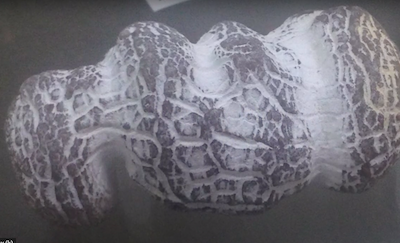
You can see how the snakeskin agate gets its name. Their unusual outer texture make them distinguishable from all other agates.
Head farther south to the McDermitt area and you will find another popular digging site for just about everything. Jasper, agate, petrified wood, opal and thundereggs can all be found here. Unfortunately, most of the historically productive rockhounding areas here have recently been claimed by a large mining company who intend to construct an open-pit mine for lithium. It looks like the best days for rockhounding at McDermitt are behind us.
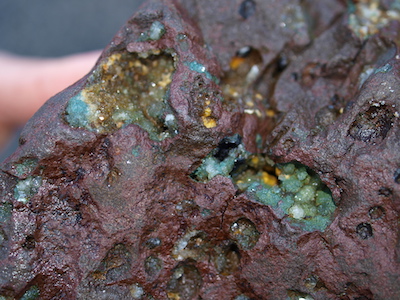
Oregon is truly a rockhounding paradise. The variety of rocks and minerals that you can find here is exceptional.
How Many Rocks Can I Collect from Public Land?
For large-scale commercial rock collection on public lands, a permit will be required. Fortunately, most of us are considered “casual” rockhounds, and do not need any special permits to collect modest amounts of rocks, gems and minerals for our own use.
The BLM has set a “reasonable” limit at 25 pounds per day, plus one piece, and total limit of 250 pounds per year. This applies for rocks, minerals, gems, invertebrate fossils and petrified wood. The “plus one piece” allows you to collect one big chunk without adding to your yearly total.
Invertebrate Fossil vs. Vertebrate Fossil Collecting in Oregon

Invertebrate fossils like clams, ammonites, and leaf impressions are fairly common at several sites in Oregon. Places that were once underwater are now exposed. Roadcuts and areas of mass-wasting erosion can expose ancient seabeds that will shed fossils.
There are lots of fossil specimens in various areas all across Oregon. It is important to note that there is a big difference in the laws regarding collection of vertebrate (no skeletal structure) fossils and invertebrate (skeletal structure) fossils.
The Rice Northwest Museum of Rocks & Minerals
I would be doing a disservice if I didn’t mention that one of the best mineral collection is located right here in Oregon. The Rice Northwest Museum of Rocks & Minerals is located in Hillsboro, about 30 minutes west of Portland.
The collection of rocks and fossils from around the world is absolutely incredible. And of course, many of the high-quality specimens are sourced right here in Oregon. Richard and Helen Rice started their rockhounding hobby back in 1938. They ended up building a custom home just to house their spectacular collection. Now there are entire rooms filled with petrified wood slabs, rare Oregon fossils, meteorites, gold, and just about any mineral you could image. If you ever find yourself in the area, this place is a MUST VISIT.
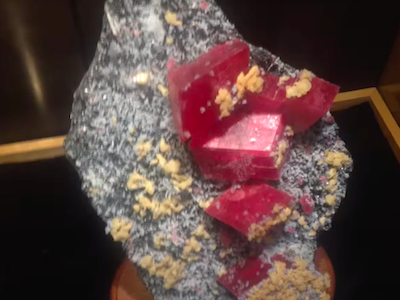
One of the finest rhodochrosite specimens ever dug is on display at the Rice Museum. The Alma Rose was found at the Sweet Home Mine in Colorado. While the museum houses some incredible Oregon gems and minerals, the collection also contains world-class specimens from around the world.
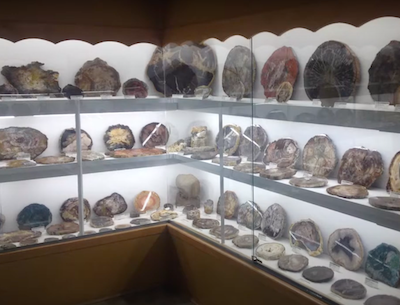
This may be the best public collection of petrified wood anywhere in the country. Most of these specimens were found in Oregon and Washington. Everything here is top-notch, high-quality, best of the best…
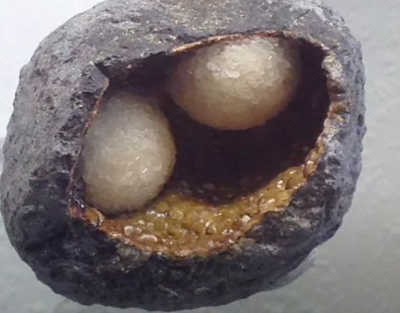
Some of the amazing minerals you see at the Rice Museum will have you asking yourself “was that really found in Oregon!?!”
Can I Keep Artifacts in Oregon?
If you spend enough time with your nose to the ground looking for rocks in Oregon, sooner or later you are going to find an artifact. At one time, there were Native Americans all over the state and it would have been common to find arrowheads just about anywhere. While that’s still true today, I find that most of the arrowheads I have found are in more remote areas with less human traffic.
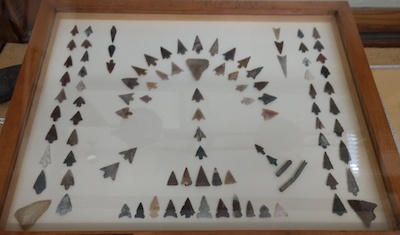
A collection of arrowheads on display at Cascade Locks, Oregon. Before there were any laws about collecting artifacts, folks would go out and collect arrowheads like this by the handful. Nowadays, there are laws that prohibit their collection on public lands. They are much less common than they once were, but they are still out there.
Just like collecting rocks, the legality will largely depend on the land ownership. On federal land, you cannot legally collect arrowheads or any type of “worked stone.” On private lands, state law says that an arrowhead may be kept, but no digging tools are allowed. And of course you need permission from the landowner.
I strongly suggest that you do not keep artifacts that you find in Oregon. Take some pictures and leave them for the next person to discover and enjoy.
What to do with your Rocks?
What you do with the rocks you collect is only limited by your imagination, but here are a few things that rockhounds like to do. A lot of rocks are perfect just as you find them, so all you really need to do is clean them up and put them on display.
Just about every rockhound I know owns a rock tumbler. You can get cheap ones starting around $40 up to a high quality Lortone tumbler that are several hundred dollars. They all work, but investing a little bit upfront is worth it if you want a quality piece of equipment. Tumblers are really fun because you can put in the more “boring” rough stones and polish them up to be beautiful. Hard stones like agates, jaspers and petrified wood all take polish very well.
Popular Rock Shows in Oregon
There are usually quite a few rock shows throughout the state that are put on by the local rockhounding clubs. They vary quite a bit in size and quality, ranging from a few guys in a garage talking about rocks to large shows at the convention center.
In my opinion, the best rock show in Oregon is the Madras Pow-Wow that takes place every summer at the fairgrounds in Jefferson County. On an average year there will be 50-75 vendors selling rocks and lapidary equipment. You’ll find lots of local materials here to add to your collection.
Pro Tip: Befriend a few old rockhounds and they might give you a few tips on places to dig.
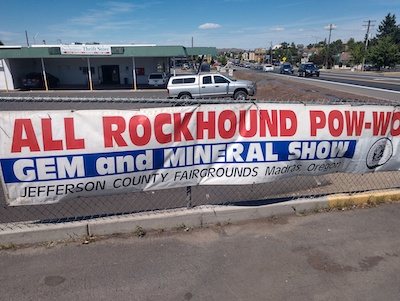
Every summer there is a great rock & mineral show at the fairgrounds in Madras, Oregon. It’s worth the visit.
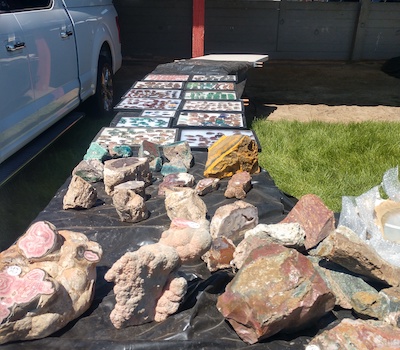
You’ll find lots of rocks here, but there is always an excellent variety of local material… lots of thundereggs and petrified wood for sale, cut and polished to perfection. Bring your wallet if you want to go home with a premium specimen!
Are you Ready to Start Finding Rocks in Oregon?
Ready to hit the field and start collecting some cool rocks yet? Here are a few recommendation to some quality books and equipment that I recommend (affiliate links). One great thing about rockhounding is that it doesn’t cost a lot of money to get started. A few basic digging tools and some guides to the best spots and you will be ready to start your collection!
Delorme Atlas & Gazetteer: Oregon – you can’t have too many maps. This is a good basic map to get you around the state. DON’T DEPEND ON PHONES OR GPS. they don’t always work. Get some paper maps and learn how to read them. Rockhounding Kit – Hammers, chisels, gloves, safety glasses, etc. Once you gain some experience you will learn undoubtedly find that you want to add some items and omit others, but a simple kit like this will get you started. Agate Hunting on the Oregon Coast – a great guidebook to 40 of the best sites for beachcombers on the Oregon Coast. Rockhounding Oregon – probably the best and most up-to-date book on rockhounding across the state. Gem Trails of Oregon – another great guide to rockhounding sites in Oregon
